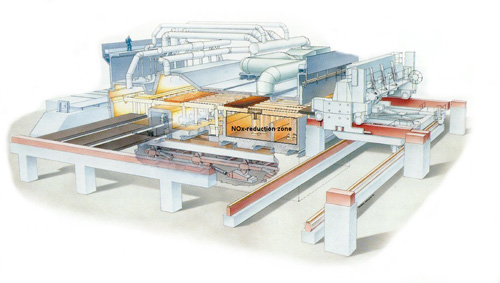
 |
|
Solutions for the steel industry ABC&I´s products in the field of NOx-reduction encompass three different methodologies. The first alternative uses a mathematical modelling method in which combustion-controlling parameters are optimised in such a way that the NOx-formation is steered to a minimum level. Used mathematical tools are CFD – and/or multivariate analysis. A typical optimisation normally leads to a NOx reduction between 10-30% depending on the complexity in the combustional system. The higher the complexity, the higher potential of NOx-reduction. Constraints are CO-level and furnace time/temperature profile for the processed steel quality. The second and third methodologies are building on chemical NOx-reduction by means of a nitrogen based reduction agent. Used technologies are SNCR- Selective Non Cathalytic NOx-Reduction or SCR- systems (Selective Cathalytic NOx-Reduction). Due to lack of cost efficiency, SCR has so far not been used in the context of steel production in ABC&I led projects. NOx-reduction in the steel industry are complex. Requirements are demanding not only on reduction in NOx but also in respect to the furnace and the conditions inside the furnace. Elimination of the potential risk of enhanced CO-emissions as well as inter activated formation of N2O are other important requirements. The internal furnace exposure from added chemicals requires high technology solutions. Well proven design, advanced construction materials together with an intelligent control system have successfully been used in reference projects during the last decade of years. Environmental benefits
Lower NOx-emissions reduces negative influence on humans as well as on other living species NOx-formation in the furnace burner zone NOx sources are:
Thermal NOx-formation and steel production constraints Gas temperatures in the flame zones of the burners are normally 1500ºC - 2300ºC, in oxyfuel applications even higher. In order to accomplish a full temperature processing profile of the steel material, the furnace gas needs to exceed temperatures in the interwall of 1100ºC - 1400ºC as a typical case. Used deNOx chemicals Investment costs- Non catalytic NOx-reduction Chemical costs Potential impact on the steel producing system The most appropriate technical design for the reduction system must incorporate type of steel mill furnace and requirements put on NOx, chemical-slipp, operational costs etc. Number and the divercity of deNOx projects delivered to the steel industry makes the ABC&I company to a leading supplier in this highly specialized field.
|

